|
 
IN
THE NEWS | PUBLISHER
| CALENDAR
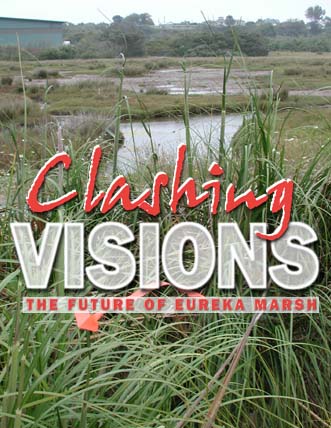
by KEITH EASTHOUSE
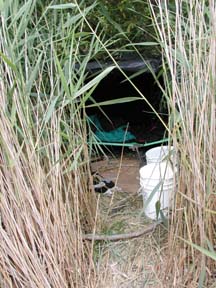 THE FIRST SIGN THAT THIS WAS NOT GOING TO be a
pristine nature experience was the trash, broken glass and empty
liquor bottles scattered on the ground near some bushes. A little
later, just off a footpath, a pile of used toilet paper announced
the presence of an open-air bathroom. Not far away, hidden in
a thicket of reeds, was a crude encampment: plastic tubs turned
upside down for chairs, a dirty sleeping bag coiled on the ground. THE FIRST SIGN THAT THIS WAS NOT GOING TO be a
pristine nature experience was the trash, broken glass and empty
liquor bottles scattered on the ground near some bushes. A little
later, just off a footpath, a pile of used toilet paper announced
the presence of an open-air bathroom. Not far away, hidden in
a thicket of reeds, was a crude encampment: plastic tubs turned
upside down for chairs, a dirty sleeping bag coiled on the ground.
"The city is just totally
neglecting this area," fumed Melvin McKinney, who has organized
numerous cleanups of the open land just north and west of Bayshore
Mall. "We've hauled 16 tons of garbage out of here."
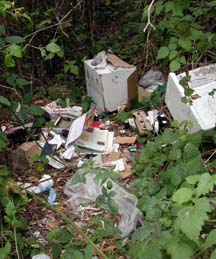 McKinney is an unusual sort. A bespectacled man
in his 80s, he used to work in the timber industry, both in the
Humboldt Bay region and down in the Fort Bragg area. He is also
a fierce environmental activist who was instrumental in pushing
the city to clean up and preserve the Elk River wildlife area. McKinney is an unusual sort. A bespectacled man
in his 80s, he used to work in the timber industry, both in the
Humboldt Bay region and down in the Fort Bragg area. He is also
a fierce environmental activist who was instrumental in pushing
the city to clean up and preserve the Elk River wildlife area.
He walks back to the main path
and joins up with the six or seven other nature-lovers who are
all out here on a gray, late-summer day for the same reason --
to raise public awareness about an area they believe could be
an asset to Eureka in the same way the Arcata Marsh and Wildlife
Sanctuary is to that city.
That the Eureka marsh -- also
known as the PALCO marsh -- has a ways to go is obvious not simply
because of the litter and the rather unsavory signs of human
habitation. It's the prevailing atmosphere of abandonment and
vague danger that, more than anything, makes it difficult to
relax and enjoy what is potentially an attractive natural area.
"I've had them run out
at me," McKinney said, referring to the transients who frequent
the marsh. "I carry pepper spray out here. You have to be
careful."
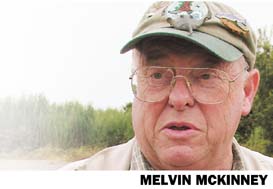 Jim Clark, conservation chair of the local Audubon
Society, grimaced in agreement. "This is scary. I'm even
afraid to ride my bike through here." Jim Clark, conservation chair of the local Audubon
Society, grimaced in agreement. "This is scary. I'm even
afraid to ride my bike through here."
Never
a priority
It wasn't supposed to be this
way. In 1985 the California Coastal Conservancy gave the city
of Eureka $610,000 to purchase the 39-acre tract known as the
PALCO marsh and surrounding lands subject to a conservation easement
held to this day by the conservancy. In all, 113 acres were bought
by the city, including marsh land both east and west of the railroad
tracks that run along this part of Humboldt Bay.
Back then, no one thought the
"marsh enhancement project," as it was called, would
remain unfinished in 2002, 17 years later. "When we gave
[the city] the grant, we didn't anticipate in 2002 that it wouldn't
be finished," said Karyn Gear, North Coast regional manager
of the conservancy.
The purpose of the deal was
to enhance the natural attributes of the area in accord with
the conservancy's mission of protecting and restoring California's
coastal resources and providing public access to the coast. For
a time things went smoothly. In 1987, the conservancy disbursed
$30,000 to the city to undertake a "marsh enhancement plan."
It was completed in two years.
The conservancy then made available
$900,000 to the city so the real work could begin -- returning
the marsh to a fully functioning tidal ecosystem through such
measures as revegetation, removing invasive species, cutting
and widening ditches and installing tide gates to improve water
circulation in the marsh.
Before the project got very
far, the city ran into a snag -- grease and solvents from a nearby
engine repair facility were found to have migrated into the southeast
corner of the PALCO marsh, right where the city had planned to
construct a 1.5-acre freshwater pond slated as a major feature
of the restored area (such ponds, havens for birds and other
types of wildlife, dot the Arcata marsh).
Due to the pollution, the project
split in two, becoming a restoration effort in the marshland
untouched by the pollution and a cleanup effort in the contaminated
areas.
An additional problem soon arose:
The Eureka Southern Railroad went bankrupt. This complicated
things since the company owned a right-of-way on either side
of a set of railroad tracks that runs adjacent to the PALCO marsh.
The tracks, elevated above the
surrounding land, are built on fill and have considerably reduced
the tidal circulation in PALCO marsh and adjacent areas. The
fix seemed simple -- install tide gates on the bay side of the
tracks to allow passage of seawater into the marsh at high tide.
But with the railroad bankrupt, there was no entity to obtain
an "encroachment permit" from to allow such work to
occur.
Faced with these two roadblocks,
the project languished.
While some restoration work
was accomplished, eight years would pass before the pollution
in PALCO marsh was cleaned up sufficiently to allow restoration
work there to resume.
Karen Kovacs, a California Department
of Fish and Game biologist familiar with the Eureka marsh saga,
said the cleanup was a legitimate delay. But she said a fundamental
reason the restoration project remains unfinished is that city
staff and city officials have never considered it of prime importance.
"The wetlands within the
city of Eureka rank equally with those in Arcata. But coastal
wetlands within [Eureka's] city limits have never been a priority
for the city."
Since the conservancy gave the
city the money -- $1.5 million in all -- it might seem that conservancy
officials would have been consistently pushing the city to get
the work done. But that does not appear to have been the case.
Part of the reason may simply
be the fact that the conservancy is a state agency that always
has lots of important projects going on; with no offices on the
North Coast, it is not easy for conservancy personnel to monitor
projects in the Humboldt Bay region. Moreover, it is unlikely
that the enhancement of an obscure bit of marshland in the middle
of Eureka was ever a top priority -- particularly after the project
was slowed by the pollution and bankruptcy problems.
"I think perhaps there
were higher priority items they were working on, and this one
was not always on their radar," said Kovacs.
Violating
a contract
By 2000, though, the conservancy
was clearly bird-dogging the project. In a Jan. 6 letter to then-City
Manager Harvey Rose, the conservancy official in charge of the
project, Mark Wheetley, expressed impatience with the lack of
progress. In particular, Wheetley complained that the city had
essentially reneged on a 1992 written agreement in which the
conservancy allowed a parking lot to be built on top of marshland
originally slated for restoration in exchange for the city undertaking
specific restoration measures elsewhere on the marsh.
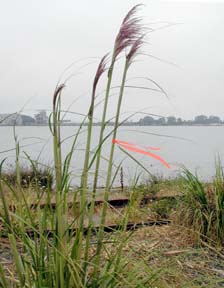 Wheetley noted that while the parking lot, intended
to provide additional parking space for the mall, was built,
the enhancement work never took place. "The conservancy
agreed [to the parking lot] subject to a number of express, written
conditions contained in [the contract]. Unfortunately, some of
these conditions -- including those imposed to protect the environment
and the restored portions of the marsh -- remain unmet despite
various exchanges of letters and other communications over the
years." Wheetley noted that while the parking lot, intended
to provide additional parking space for the mall, was built,
the enhancement work never took place. "The conservancy
agreed [to the parking lot] subject to a number of express, written
conditions contained in [the contract]. Unfortunately, some of
these conditions -- including those imposed to protect the environment
and the restored portions of the marsh -- remain unmet despite
various exchanges of letters and other communications over the
years."
Photo at left:
Railroad bed and pampas grass, an invasive species
While Wheetley doesn't say so
in the letter, the city had violated the 1992 contract in another
way. The contract allowed the city to lease over two acres of
the six-acre "poleshed property," as this parcel is
called, to Bayshore Mall -- on the condition that the property
be used for parking and parking alone: "Use of the parking
area shall be restricted to parking. No structures shall be erected
on the poleshed property, except as appropriate to implement
the marsh enhancement plans."
What's on the parking lot today?
Parking spaces, of course, including 28 at the north end reserved
for marsh visitors; but also the Oasis Fun Center, which operates
a go-cart track, and a scrap metal outfit called Zink's Recycling.
When asked if the presence of these businesses on the poleshed
property wasn't a clear violation of the 1992 contract, Moira
McEnespy, Wheetley's successor at the conservancy, conceded that
it was. But she said the conservancy is most concerned at this
point "that the city move forward and get the [restoration]
work done."
The city, in a two-paragraph,
unsigned document recently made available to the conservancy,
ignores the fact that it is out of compliance with the 1992 contract.
Instead, it states that "the city has verified [that the
two businesses] have both obtained the licenses and permits required
to properly conduct their respective operations" -- as if
that obviates the violation. The statement goes on to say both
businesses "operate at the lower end of the marsh and do
not impact the designated marsh parking or public access."
To McKinney and other critics that's beside the point. "They're
in violation of the contract, plain and simple," McKinney
said. "There's only supposed to be parking down here."
This issue wouldn't bug McKinney
and other marsh supporters so much were it not for the fact that
the go-cart facility in particular seems at odds with restoring
the Eureka marsh to its natural state because the vehicles make
so much noise. "It really roars. It's totally loud,"
said Christine Ambrose of the Environmental Protection Information
Center.
While the conservancy is apparently
willing to tolerate these businesses, there's no question that
it never intended the poleshed property to be the source of loud
noise. That's made clear in another provision of the 1992 contract
pertaining to construction of the parking lot. "All construction
shall be accomplished in a manner minimizing disruption to PALCO
marsh," the provision states.
A couple of other aspects of
the 1992 agreement have also not been honored: a commitment from
the city to post signs "from the nearest public roadway"
(meaning Highway 101) directing the public to the marsh parking
area; and to erect a "marsh interpretive display" either
inside Bayshore Mall or in the vicinity of the marsh parking
area. Ten years after the contract was signed, neither have happened.
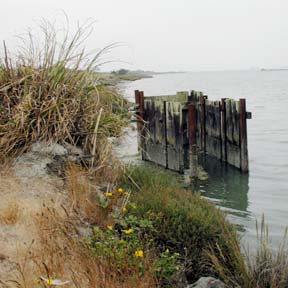 Tidal
gates Tidal
gates
Mike Zoppo, property manager
for the city, told the conservancy in an e-mail in April that
the city and the mall would use the results of a larger effort
called the "Humboldt Bay Signing Program" to produce
the display. That program is being developed by the Redwood Community
Action Agency, a local nonprofit organization.
As for the signs, the conservancy
sent a letter in early July asking that the city submit a plan
for its approval describing "the number, design, placement
and wording of the signs," which are supposed to include
an acknowledgement of conservancy funding in restoring the Eureka
marsh. As of early September, the conservancy had "not received
a sign plan from the city, nor an indication of when [such a
plan] will be forthcoming," according to a "project
update" that conservancy staff is presenting to conservancy
officials at a meeting in Orange County this week.
One more thing: According to
that two-paragraph statement from the city, "the mall strictly
enforces their policy against overnight camping" in the
parking lot. But the statement goes on to acknowledge that, in
fact, camping occurs there. "From time to time and mostly
during the summer months, travelers with self-contained trailers
and motor homes may spend the night at any one of the mall's
parking areas."
Dragging
its feet
The project update lists other
shortcomings in the city's performance on the marsh restoration
project. They include:
• The city is dragging its feet on reviewing a restoration
plan for the Eureka marsh.
In February, Spencer Engineering
submitted "Draft Final Plans, Specifications and a Construction
Cost Estimate" to the city that outlines the restoration
work remaining to be done in the Eureka marsh. At that point,
according to McEnespy, "the hope" was that actual restoration
work could take place by the summer -- although she said she
knew that it could take longer since the plan would have to be
reviewed by other agencies, such as the California Coastal Commission
and the California Department of Fish and Game.
What McEnespy didn't anticipate
was that the plan would get mired in the city's bureaucracy.
On June 4, in response to inquiries
from the conservancy, the city's deputy engineer, Gary Boughton,
said he would review the restoration plan in July. In response
to a follow-up query from the conservancy, Boughton said he had
forwarded the restoration plan to the city's Community Development
Department to determine whether an updated environmental review
would be required.
On Aug. 6, conservancy staff
asked the city for more information -- in particular, when specific
restoration projects would take place and when the restoration
plan itself would be reviewed by other agencies. On Aug. 22,
the city submitted something that was presented to the Eureka
City Council at a meeting on July 16: a one-page "proposed
project schedule" that says the project will be completed
by October of 2003. The schedule, which contains few details,
lays out a timeline for "submitting applications" and
obtaining permits from outside agencies. But it does not make
clear when the restoration plan would be circulated to other
agencies for review -- a critical concern to the conservancy
since a previous restoration plan for the area, crafted in the
late 1980s and early 1990s, has fallen seriously out of date.
"We want anything we fund
to be the best plan it can be so we look to agencies like Fish
and Game for guidance because they have the resource experts,"
explained McEnespy.
The proposed project schedule
is also just plain confusing. It says that an "updated marsh
enhancement plan and environmental document" will be completed
by July 2002 -- in other words, two months ago. That's left conservancy
staffers scratching their heads. "As of this writing,"
staff says in its report to conservancy officials, "there
is no indication whether the city has accomplished this task
-- or, indeed, what it has in mind for those documents."
The episode appears to be emblematic
of the entire project, and a sign that the city, despite taking
$1.5 million from the conservancy, does not consider the project
important.
"You don't anticipate a
seven-month review time (of the plan from Spencer Engineering)
with still no word on what's happening," McEnespy said.
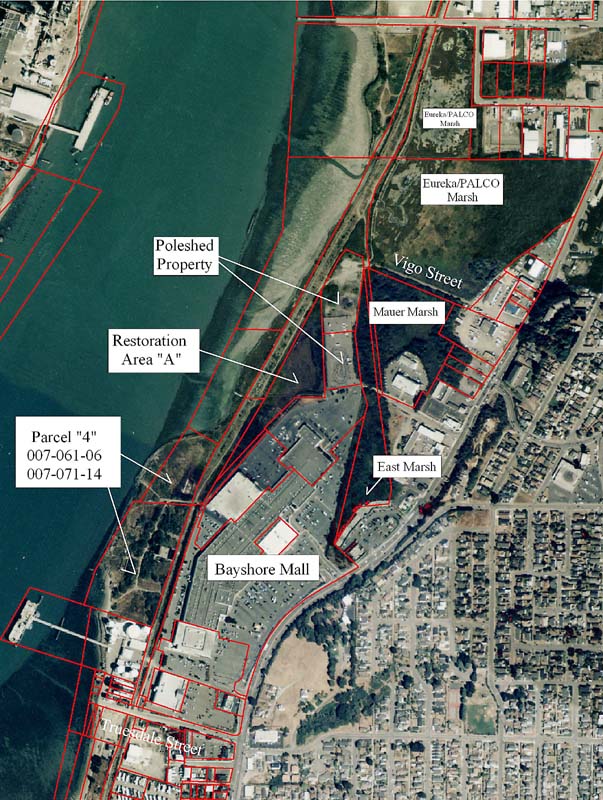
Aerial photo of Eureka Marsh
courtesy of U.S. Fish & Wildlife Service, 1997
• A conservation easement important to the goal of
restoring tidal circulation to part of the marsh has never been
recorded with the county -- despite the fact that the city agreed
to impose such an easement in a legally binding contract with
the conservancy.
The conservation easement pertains
to a parcel west of the poleshed property called "Restoration
Area A." The parcel, which is undeveloped, was not part
of the 1985 marshland acquisition and is owned by Bayshore Mall.
Nonetheless, given its location in the midst of the marsh, conservancy
staff says it must remain undeveloped if the restoration work
is to be successful -- hence the need for a conservation easement.
"The easement must, among
other things, be adequate to allow enhancement, restoration,
maintenance and monitoring," conservancy staff says in the
project update.
According to the update, Brent
Siemer, the city's engineer and public works director, informed
the conservancy in April "that only a separately required
access easement has been recorded [in 1994 that was] in favor
of the mall."
On July 3 conservancy staff
sent a written request that the city draft for its review a conservation
easement for Restoration Area A. The city has not responded.
McEnespy refused to speculate
about why the conservation easement has not been recorded. Ambrose
with EPIC suspects that the city is afraid a conservation easement
in that location would interfere with its Waterfront Drive Extension
Project, which is supposed to run south of the mall and hook
up to Highway 101 via Truesdale Street. (See story
below, "Incompatible projects")
• The city has never come forward with a serious
proposal for developing 15 acres of marshland that was part of
the 1985 acquisition. Yet the city does not want to see the land
protected and put off-limits to development.
"Parcel 4," as it
is called, comprises 15 acres of wetlands and drylands squeezed
in between Bayshore Mall and Humboldt Bay.
Under the terms of the 1985
deal, the city had 10 years to come forward with a proposal to
develop that land. If such a proposal was not forthcoming, the
conservancy could at any time after 1995 impose an "open
space easement" that would permanently protect the land
from development.
In an Aug. 22 letter to the
conservancy, City Manager David Tyson reiterated the city's desire
to develop the area. He said that the city is looking at "two
primary project proposals: development of an aquaculture/industrial
park facility and a marine terminal facility." He said that
part of the reason the parcel has never been developed is "the
absence of an operating rail transportation system in our region."
McEnespy said the conservancy
is sympathetic to the city's wishes regarding Parcel 4 in part
because it's zoned for industrial use. But, as the staff's project
update notes, the city has never submitted concrete development
plans despite several requests from the conservancy.
The city has also not addressed
the question, according to the update, of whether such plans
would conflict with the fact that the city was allowed to destroy
wetlands as part of the Eureka Waterfront Boardwalk project in
exchange for leaving Parcel 4 alone.
Tyson speaks of the possibility
of having Parcel 4 serve as a "mitigation bank" (a
place to leave undeveloped so that development can take place
elsewhere). But he suggests that the conservancy consider removing
its right to impose an open space easement on Parcel 4 to "another
piece of city property."
Conservancy staff said it "would
consider any viable proposal the city submits, but none has yet
been submitted."
A
different vision
The folks who want to see the
Eureka marsh become a wildlife preserve and visitor destination
on par with Arcata's believe that city officials simply don't
get it.
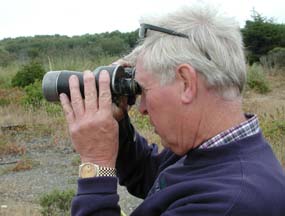 "It's
a quality of life thing, it's about what makes a city livable,"
said Dennis Cahill, a biology teacher at Eureka High. [photo at right] Standing
out in the marsh with Humboldt Bay behind him, Cahill said bluntly
"the city of Eureka views the marsh as a problem and not
an asset. That's the problem." "It's
a quality of life thing, it's about what makes a city livable,"
said Dennis Cahill, a biology teacher at Eureka High. [photo at right] Standing
out in the marsh with Humboldt Bay behind him, Cahill said bluntly
"the city of Eureka views the marsh as a problem and not
an asset. That's the problem."
Christine Ambrose agreed, adding
that the preoccupation of city officials with port development
and the Waterfront Drive extension project (the road would cut
right through the marsh) is blinding them to the importance of
restoring Eureka marsh.
"The idea that Humboldt
Bay can compete with San Francisco Bay as a port is illusory.
We'll end up with a bunch of brownfields, a deserted, polluted
area.
"We need an alternate vision,"
she continued, "one that's more environmentally sustainable.
This could be a nature research study area."
The city's
view
by GEOFF
S. FEIN
 CITY
MANAGER DAVID TYSON [photo
at left] acknowledges the importance
of wrapping up the PALCO Marsh Restoration Project, as the city
calls it. But he pointed out that the public works staff (between
five and 10 people) responsible for the project have a lot of
projects on their table. CITY
MANAGER DAVID TYSON [photo
at left] acknowledges the importance
of wrapping up the PALCO Marsh Restoration Project, as the city
calls it. But he pointed out that the public works staff (between
five and 10 people) responsible for the project have a lot of
projects on their table.
"Staff are working on this
project to move it forward," he said. "As well as the
other 100-plus projects they are working on."
To date the city has spent $1.1
million of the $1.5 million given to it by the California Coastal
Conservancy to acquire and restore the PALCO marsh and surrounding
lands. The entire marsh area north and west of Bayshore Mall
is also known as the Eureka marsh.
According to one Eureka City
Council member, the project has taken far too long. But city
officials claim it wasn't a matter of the city dragging its feet,
but a series of circumstances that led to the delays: contaminated
soil, discovered early on, stretched out the time-line; the Eureka
Southern Railroad going broke added a few more years to the project;
changes in the Coastal Conservancy's project manager delayed
things even further; and then a new project design, which entailed
refiling permits, added to the delay.
The biggest delay was produced
by the contamination, which took eight years -- from 1991 to
1999 -- to be cleaned up, Deputy Engineer Gary Boughton said.
"It took a long time to
get clearance for the contamination clean-up," Boughton
said. "Contracts with the regulatory agencies took a number
of years."
The finding of contamination
led to the project being split up into two phases. That produced
a whole new set of bureaucratic delays.
By April 1999, after the cleanup
was done, the city was set to proceed with Phase 2 of the project,
essentially finishing up the restoration work. But city officials
realized that much had changed since the initial restoration
work and that major revisions to the restoration plan were needed.
Additionally, new specifications and cost estimates had to be
drafted.
To keep the plans moving, the
city began working with the Redwood Community Action Agency,
a local nonprofit agency that had been involved in monitoring
the effectiveness of the restoration work that was done in the
late 1980s and early 1990s. The idea was that it should be involved
in the new restoration effort that was in the works.
But, according to city documents,
attempts in the summer of 1999 to get the conservancy's approval
to hire the RCAA proved futile. It wasn't until September 2000
that the city was finally able to get a response from the conservancy.
By then the city backed off
of its construction plans because of the looming winter.
Part of the problem was that
there was apparently a period of time when no one at the conservancy
was responsible for the project. An earlier project manager had
left and was not replaced until January 2001.
In July 2001, city officials
and the conservancy took various state and federal officials
on a tour of the site. That led Fish and Game staff to ask for
a redesign of a major feature of the restoration effort: construction
of a freshwater pond. That produced a further delay, as the redesign
would require new permits from both the California Coastal Commission
and the Army Corps of Engineers.
Chris Kerrigan, Eureka city
councilman [photo at right], acknowledges the process to restore the marsh
has taken too long. But he said the project will be completed.
"This council affirmed
its commitment to getting the improvements done," he said,
referring to the action taken in July approving a timeline that
says the project will be completed by October 2003. n
Incompatible projects?
For more than 30 years, Eureka
city officials have known that something would eventually need
to be done about traffic on Highway 101. Numerous plans have
been considered. But because of the enormous cost of building
a bypass around the city -- as high as $300 million -- and certain
opposition from neighborhoods to alternative routes within city
limits, officials have been left with few options.
The current choice, approved
recently by the council, is a proposal to extend at a cost of
$6 million Waterfront Drive from Del Norte Street south to Truesdale
Avenue. One problem with the route is that it would run right
through the middle of 113 acres chunk of marshland slated for
restoration under a $1.5 million agreement between the city and
the California Coastal Conservancy.
The road would be built alongside
-- perhaps on top of -- already existing railroad tracks that
are located inside a right-of-way owned by the North Coast Railroad
Authority. As a result, an open space easement held by the conservancy
on the land slated for restoration does not apply. Legally speaking,
in other words, there's nothing stopping the city from putting
a road in there.
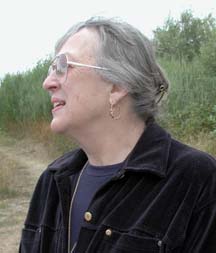 Nonetheless,
those who see the marsh as a potential nature preserve equal
to the Arcata Marsh and Wildlife Sanctuary say the road and marsh
restoration projects are incompatible. Nonetheless,
those who see the marsh as a potential nature preserve equal
to the Arcata Marsh and Wildlife Sanctuary say the road and marsh
restoration projects are incompatible.
"The road would cut the
wetlands off from the bay," said Christine Ambrose of the
Environmental Protection Information Center. "It would negatively
impact its ability to function as a wildlife refuge."
Added Diane Beck of the local
chapter of the Sierra Club: "The road would destroy the
whole idea of the marsh being connected to the bay." [photo at right]
Karen Kovacs, a wildlife biologist
with the California Department of Fish and Game, said that because
the railroad tracks are built on fill, no wetlands would be destroyed
by routing the road through the marsh area. She said, however,
that noise generated by the road would degrade the natural qualities
of the area.
She also said that wildlife
would be directly impacted -- through road kill of small mammals,
by blocking passage between the marshlands east and west of the
road and by birds flying directly into the windshields of cars.
"Rails don't fly high," she said, referring to one
bird species, "and a lot of shore birds tend to fly out
and away [rather than up] when disturbed. There will clearly
be opportunities for birds to be directly impacted."
According to Brent Siemer, city
public works director, the two-lane, 40-foot wide road would
be designed to prevent effects to the marsh. For example, a "bioremediation
swale" -- a ditch to handle and control roadway runoff --
would be built alongside the road, he said.
Earlier this year, the city
received $250,000 in state transportation funds to do a project
design and an environmental impact review for the Waterfront
Drive extension. The EIR will detail impacts to the marsh, potential
ways to resolve those impacts, and numerous alternatives to the
new road. That process is expected to take 18 months.
Opponents of the Waterfront
Drive project asked the city not to proceed with the EIR. But
without the document, the effects on the marsh cannot be known.
"Until we look at the environmental
picture, we won't know the impacts," said Chris Kerrigan,
a city councilmember.
But before anyone accuses Kerrigan
of changing his environmental views, he does have serious doubts
about a road through the wetlands.
"I've got concerns with
putting a 50 m.p.h. truck route through there," he said.
"The city should protect and preserve open space."
-- Geoff S. Fein and Keith
Easthouse
IN
THE NEWS | PUBLISHER | CALENDAR
Comments? E-mail the Journal: ncjour@northcoast.com

© Copyright 2002, North Coast Journal,
Inc.
|